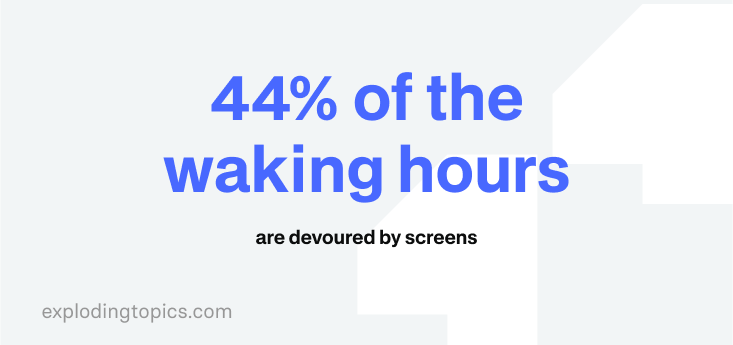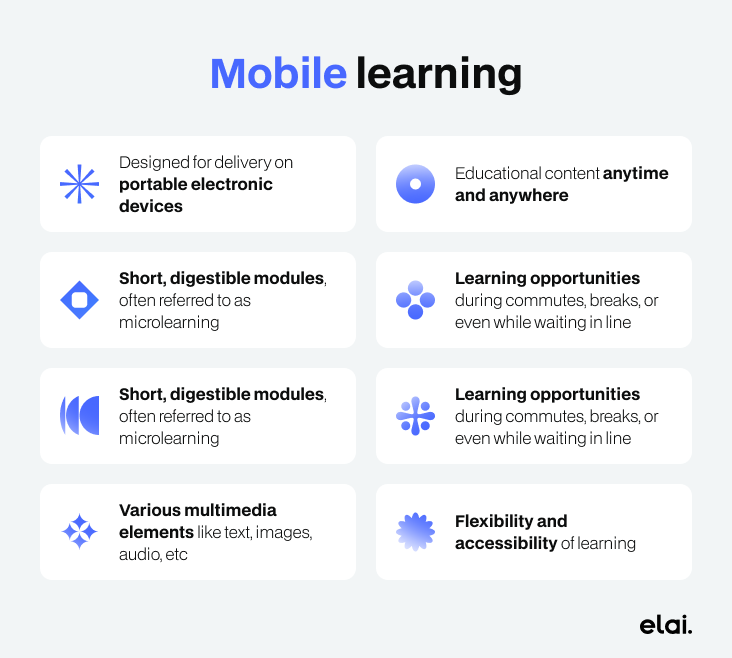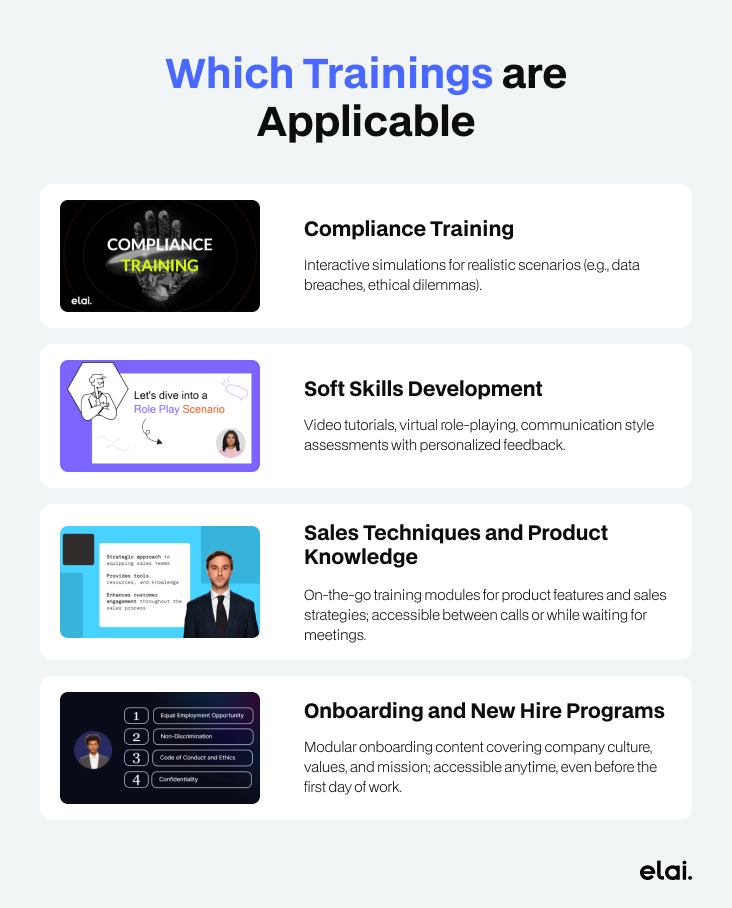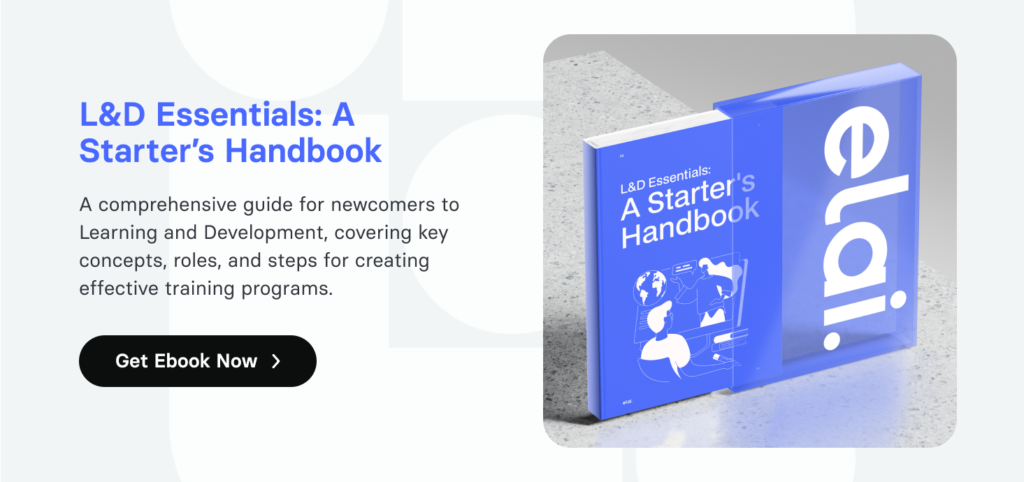Do you know a foolproof way to motivate employees for ongoing knowledge enhancement? Probably, not, we don’t either. There’s an efficient tool still to increase employee engagement by 70% (source).
The game-changer for corporate training is mobile learning (mLearning), which enables people to fit in a learning session during a commute, waiting at the airport, or a quick lunch break. Forget the days of cramming employees into conference rooms for day-long training sessions. Flexibility and accessibility are key drivers of employee satisfaction.

Since screens devour 44% of the waking hours on average (source), mLearning capitalizes on this by delivering bite-sized learning exactly when you need it most – in those micro-moments throughout the day.
Create an optimal mobile learning strategy – these time pockets translate to a more skilled, motivated workforce equipped to tackle challenges and drive business growth. But what exactly makes mLearning so compelling? Let’s dive deeper and explore the key benefits that are propelling this mobile learning revolution.

Mobile Learning 101: Definition
Mobile learning, also known as mLearning, refers to a form of education specifically designed for delivery on portable electronic devices like smartphones and tablets. It capitalizes on the ubiquity of these devices, allowing learners to access educational content anytime and anywhere.
mLearning content is typically broken down into short, digestible modules, often referred to as microlearning. This format caters to shorter attention spans and busy schedules, enabling learners to squeeze in learning opportunities during commutes, breaks, or even while waiting in line.
The content itself can encompass various multimedia elements like text, images, audio, and video, making the learning experience engaging and interactive. Assessments, quizzes, and gamification elements can also be incorporated to promote knowledge retention and track progress.
Mobile learning platforms typically offer features like cloud storage, offline access, and progress tracking, further enhancing the flexibility and accessibility of learning. This empowers learners to take control of their own learning pace and revisit specific modules as needed.
Mobile learning is not confined to a specific industry or sector but is increasingly prevalent in corporate training, education, healthcare, and beyond. Its widespread adoption is driven by advancements in technology, increased accessibility to mobile devices, and the growing demand for modernized learning strategies. From the Me@Walmart app, designed to empower employees and attract new hires, to a robust internal training program of Hilton University, businesses strive to prime their teams for success with m-learning.

Sweet Spot: Which Trainings are Applicable
While not a one-size-fits-all solution, mobile learning in education shines in specific domains of professional training.
Compliance Training
With the rise of remote work, mobile corporate training allows organizations to reach dispersed employees with compliance training. Interactive simulations allow for immersing employees in realistic scenarios, such as data breach incidents or ethical dilemmas. It enables employees to apply compliance principles in simulated environments, reinforcing understanding and fostering ethical decision-making skills crucial for regulatory compliance in their roles.
Soft Skills Development
One conversation can change a lot. For it to be a productive one, a wide range of interpersonal, communication, and leadership abilities is needed. Through video tutorials, virtual role-playing exercises, and communication style assessments, employees can practice effective communication techniques and receive personalized feedback to improve their interactions with colleagues, clients, and stakeholders.
Sales Techniques and Product Knowledge
Sales success demands agility in navigating trends, customer needs, and competitor strategies. M-learning allows accomplishing it in between calls, or even while waiting for a client meeting. Reps struggling with a specific product feature can access targeted training modules, while those excelling in a particular area can delve deeper through advanced training materials.
Onboarding and New Hire Programs
Do you recall this feeling of struggle to remember everything you were told in a single, jam-packed orientation session? The experience doesn’t have to be this overwhelming nowadays.
Mobile learning in the workplace offers a streamlined approach by delivering company culture, values, and mission statement information in easily accessible modules. This allows new members to absorb the information at their own pace, even before their first day of work. The convenience fosters a sense of belonging and connection from the very beginning of their employment journey.

Beyond the Hype: Challenges and Considerations
While mobile learning (mLearning) offers a wealth of benefits for corporate training, it’s not without its challenges. Here’s a closer look at some hurdles to consider when implementing mLearning programs.
Keeping Eyes Glued
Short attention spans and information overload are realities in our hyper-connected world. Overly text-heavy content or repetitive formats can lead to disengagement and hinder knowledge retention.
Bridging the Gap
Connectivity isn’t universal, with access to blazing-fast internet and top-of-the-line smartphones remaining out of reach for some. To ensure inclusivity, mobile learning programs should account for diverse devices and potential connectivity limitations. Offering offline access to downloaded modules and maintaining compatibility with older operating systems are essential considerations.
Gauging the Gains
Measuring the effectiveness of training programs in this format requires a different approach compared to traditional classroom settings. Traditional tests don’t translate well into m-learning while engaging content doesn’t automatically equate to deep learning. Finding ways to assess knowledge gained beyond participation is key for the actual progress to happen (endless quizzes won’t cut it, unfortunately).
Crafting Captivating Content
Making high-impact mobile learning content involves both planning how people learn best (instructional design) and making the information clear and fun (using the game element). The ABCD Model of Objectives can help with planning, and 20 Techniques of Gamification will give you ideas for the fun part.
Counting the Costs
Developing and maintaining a mobile learning platform requires investment. While the potential long-term benefits outweigh the costs, considering factors like content creation, platform subscriptions, and potential hardware upgrades all come with a price tag.
However, there are ways to optimize costs. AI-powered video generation tools, such as Elai.io, can become a powerhouse for creating high-quality content at a fraction of the traditional cost, allowing organizations to maximize the ROI of their mobile learning investment.
From Passive to Motivated: Engagement&Retention Strategies
Captivating a pocket-sized guide in place of a dense textbook already sounds good. But just like a captivating story needs more than just a good opening line, mobile learning needs strategies to keep your employees hooked. Here are some of the most useful ones, aligned with the latest mobile learning trends.
Microlearning
Attention spans are shorter than ever, and learners crave information they can absorb quickly. Microlearning modules, typically under 5 minutes, cater to this reality by delivering focused content in a digestible format.
It can be easily revisited and repeated at increasingly spaced intervals. This spaced repetition technique strengthens memory and helps learners retain knowledge for the long term.
Interactive Storytelling
Stories activate brain regions linked to memory, emotion, and decision-making (as storytelling expert Robert McKee highlights). Interactive storytelling leverages this by immersing learners in narratives, fostering deeper connections with information, and promoting active learning through choices and consequences. Branching narratives further enhances by allowing learners to explore the impact of their decisions, creating a more engaging learning experience.
Learner-Centric Design
The key to a successful mobile learning program lies in effective delivery, not just the content itself. Learner-centric design empowers this by offering personalized learning paths that cater to individual needs and experience levels.
This approach extends to learning autonomy. Employees can choose the pace, sequence, and format that best suits their learning style. Imagine offering pre-recorded video lectures alongside interactive quizzes, giving them the freedom to choose how they learn the same material.
Social Learning
Mobile learning’s flexibility can feel isolating. Social learning features combat this. Discussion forums connect colleagues, fostering knowledge exchange. Gamified elements like leaderboards add a competitive edge, while designated experts within the platform bridge knowledge gaps. This creates a collaborative environment where everyone benefits from shared wisdom.
Unleashing the Power of M-learning with Elai
Developing traditional training videos can be expensive and time-consuming. AI platforms eliminate the need for actors, studios, and complex editing software. Simply input your text, choose your avatar and language, and the platform generates a professional-grade video in minutes. This translates to significant cost savings and allows your HR and L&D teams to focus on developing engaging content, not logistics.
That’s where AI-powered video generation from Elai.io cuts through the complexity. We’ve harnessed the power of artificial intelligence to create a platform that empowers you to develop diverse training materials in minutes, not weeks.
Imagine crafting professional-grade explainer videos with a cast of 80+ high-quality avatars, all without the need for actors, studios, or complex editing software. Our platform lets you choose from over 75 languages and 450+ accents to ensure your message resonates globally.
Realistic AI-generated avatars aren’t just visually appealing; they tap into our natural tendency to connect with human-like faces. This creates a more engaging and emotionally resonant learning experience. Think about a training video on financial regulations. A professional-looking avatar explaining critical concepts fosters learner trust and engagement with the material. Now, imagine a soft-spoken, empathetic avatar guiding new employees through onboarding. This personal touch creates a sense of warmth and belonging, making the learning experience more welcoming.
Don’t have a script in mind? No problem! Simply select a template from our library of 100+ pre-designed options, and our AI will transform your text into a clear and concise video lesson – perfect for bite-sized microlearning modules.
Beyond visuals, our videos offer interactive quizzes directly within the videos to assess understanding and reinforce key concepts on the fly. Imagine a scenario-based training video where your employees choose a course of action. The video adapts based on their selection, offering real-time feedback and branching narratives that create a truly immersive and interactive learning experience.
Ready to transform your corporate training? Elai.io empowers you to create a mobile learning program that’s not just informative – it’s captivating. Visit our website today and discover how our All-in-One AI video generator empowers HR and L&D teams to produce interactive videos without the need for microphones, cameras, or studios. Take advantage of a free trial and experience the power of mobile learning at its finest!
FAQ
What is mobile learning in education?
Mobile learning, also known as mLearning, refers to the use of smartphones, tablets, and other portable devices to access educational content and engage in learning activities. This method empowers learners with the flexibility to learn anytime and anywhere, fitting study sessions into their busy schedules. Mobile learning often utilizes engaging formats like videos, quizzes, and interactive elements, making the learning process more enjoyable and potentially leading to improved knowledge retention.
How to develop a mobile learning strategy?
Developing a successful mobile learning strategy requires careful planning. First, define your learning objectives and target audience. Then, prioritize bite-sized content, optimize for smaller screens, and incorporate engaging elements like videos, quizzes, and gamification. Consider using realistic AI-generated avatars in your learning videos to create a more personalized and immersive experience for learners. Ensure your chosen platform is accessible offline and fosters interactivity. By focusing on these key points, you can create a mobile learning experience that is convenient, engaging, and effective.
What is the future of mobile learning in education?
The future paints a picture of personalized, just-in-time learning experiences. Imagine AI-powered chatbots providing microlearning modules based on individual roles and performance gaps. VR simulations could put employees in realistic work scenarios, while AR overlays could guide them through complex tasks on the job. This hyper-focused, accessible learning will empower employees to upskill and adapt quickly, driving increased productivity and organizational agility.

